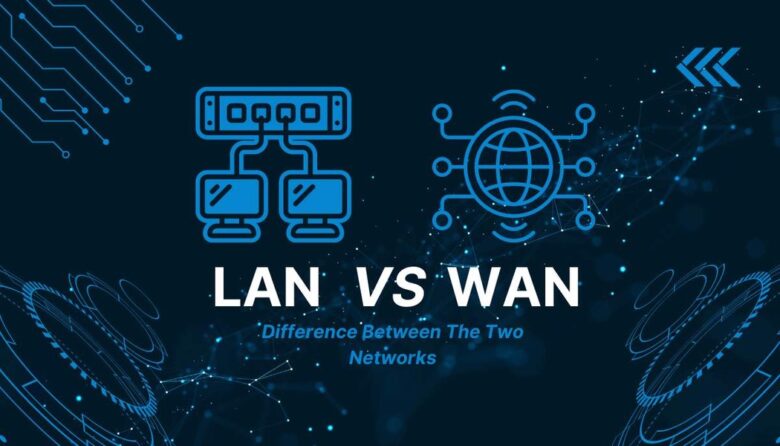In today’s fast-paced digital world, networks are essential for connecting people, devices, and businesses around the world. People often compare Local Area Networks (LANs) and Wide Area Networks (WANs), two basic types of networks. Both LANs and WANs, while designed to facilitate communication and information exchange, serve different purposes and offer distinct advantages and disadvantages. Understanding the differences between the two is crucial for IT professionals, businesses, students, and anyone who needs to connect to the internet.
Local, private environments like homes and businesses typically use LANs, whereas WANs connect larger areas, often spanning across countries and continents. The type of network you choose affects speed, cost, security, and overall efficiency. This article describes the key differences between LANs and WANs, including how they work, when they are used, and why these differences are so important in today’s technology.
What Does the Term LAN Mean?
A LAN, or local area network, is a private network typically available only within a small area, such as a home, school, or office building. LANs are known for their rapid data transfer, low latency, and low implementation costs. They allow people to easily share files, printers, and internet connections, making them ideal for small businesses or homes. Ethernet cables or Wi-Fi are typically used to connect devices to a local area network (LAN), while a central router or switch usually manages the LAN. LANs are highly secure and easy to operate because they operate over short distances. A major advantage of LANs is that you can customize network settings to your needs without relying on third-party providers.
What is a Wide Area Network (WAN)?
A Wide Area Network (WAN) covers a much larger area than a Local Area Network (LAN). A WAN can connect multiple LANs across cities, countries, or even continents. The internet is the most common example of a wide area network, connecting billions of devices worldwide. WANs typically rely on third-party service providers (such as telecommunications companies) for connectivity, while local area networks are managed by their owners. WANs use technologies like fiber optic cables, satellite connections, and leased lines to connect over longer distances. Because WANs cover larger areas, they are generally slower and have higher latency than local area networks (LANs). WANs are also pricier to install and maintain. However, wide area networks (WANs) are crucial for multinational corporations, online retailers, and global communications.
Differences in Speed and Performance:
Speed and performance are the two principal differences between local area networks (LANs) and wide area networks (WANs). LANs are typically very fast, reaching speeds of up to 1 Gbps or even 10 Gbps in more modern facilities. This makes them ideal for gaming, streaming media, and transferring large files. WANs, on the other hand, must handle large amounts of data over long distances, which can slow speeds to a few Mbps to several hundred Mbps, depending on the infrastructure. Latency is another issue with WANs, as data must travel over long distances. 5G and fiber optic technology have significantly increased WAN speeds, but in terms of pure performance, LANs remain the best choice for local use.
Implementation Costs:
LANs and WANs also differ significantly in cost. Setting up a local area network (LAN) is inexpensive because it requires only basic networking equipment such as switches, routers, and cables. LANs also have lower maintenance expenses because they cover a smaller area and can be maintained internally. Wide Area Networks (WANs), on the other hand, are pricier because they require specialized infrastructure, long-distance connections, and a service provider. Companies that deploy WANs across multiple locations can spend significant amounts on leased lines, satellite communications, and security solutions to maintain their operations. Therefore, a local area network (LAN) is a better choice for individuals or small organizations because it is less expensive; for larger enterprises, a wide area network (WAN) is necessary, despite the higher cost.
Security Aspects:
Both local area networks (LANs) and wide area networks (WANs) have their security challenges and solutions. Because LANs are private and have a limited coverage area, they are generally considered more secure. Network administrators can use firewalls, encryption, and access control to ensure the security of local data. On the other hand, wide area networks (WANs) pose a higher security risk due to their size and connection to public networks such as the internet. WANs are always vulnerable to hackers, malware, and cyberattacks, making strong security protocols, VPNs, and advanced firewalls essential. Both local area networks (LANs) and wide area networks (WANs) require protection, but securing a WAN is more difficult and resource-intensive than securing a local area network (LAN).
Applications and Uses:
Because LANs and WANs are different types of networks, their applications differ significantly. LANs are suitable for small locations, such as homes, schools, and small organizations, that focus on rapid data exchange and resource management. For example, a LAN can connect computers, printers, and servers within the same building. WANs, on the other hand, are essential for long-distance connectivity and communication. WANs enable multinational corporations to connect offices in different locations, allowing employees to collaborate and share data. WANs are also crucial for e-commerce, cloud services, and remote working. In short, LANs are well-suited for small-area networking needs, while WANs are best suited for global business operations and communications.
The Future of LANs and WANs:
Technological advancements are changing the future of LANs and WANs. LANs are constantly evolving with the increasing speed of Ethernet standards, developments in Wi-Fi technologies (such as Wi-Fi 6 and Wi-Fi 7), and the increasing connectivity of smart home devices. Wide area networks (WANs) are also changing thanks to the development of 5G networks, satellite internet services like Starlink, and software-defined networking (SD-WAN). These new technologies are closing the performance gap between local area networks (LANs) and wide area networks (WANs). WANs are becoming faster and more reliable, while local area networks (LANs) are becoming more streamlined and user-friendly. In the coming years, the integration of cloud computing, the Internet of Things (IoT), and edge computing will also change the way LANs and wide area networks operate.
Conclusion:
IIn short, local area networks (LANs) and wide area networks (WANs) are both crucial to modern networking; however, they serve different functions. LANs are ideal for homes, schools, and offices because they can connect people within a small area quickly, inexpensively, and securely. WANs, on the other hand, can connect people over large distances, enabling communication and collaboration worldwide, albeit at a higher cost and complexity.
YYou must choose between a local area network (LAN) and a wide area network (WAN) depending on your needs for either local efficiency or global reach. Technological advancements have blurred the distinction between LANs and WANs, yet their respective responsibilities continue to be crucial in defining the digital landscape. Understanding these differences can assist individuals, businesses, and organizations in making informed choices about network deployment in a world increasingly dependent on seamless communication.
FAQs:
1. What is the main difference between a local area network (LAN) and a wide area network (WAN)?
The fundamental difference is that a local area network (LAN) is fast and inexpensive but has a smaller coverage area; a wide area network (WAN) has a larger coverage area and can connect multiple local networks but is slower and pricier.
2. Is the internet a local area network (LAN) or a wide area network (WAN)?
The internet is considered the world’s largest wide-area network (WAN) because it connects billions of devices worldwide over long distances.
3. Which is faster, a local area network (LAN) or a broadband network (WAN)?
LANs are faster than WANs because they cover a smaller area and can reach speeds of over 1 Gbps. WANs are slower because they must transmit data over greater distances.
4. Which is more secure, a local area network (LAN) or a broadband network (WAN)?
A local area network (LAN) is generally more secure because it is private and easy to manage. A broadband network (WAN), on the other hand, requires more advanced security measures because it connects to the public internet.
5. Can a local area network (LAN) and a broadband network (WAN) work together?
Yes, a local area network (LAN) and a broadband network (WAN) can often work together. A company can use a local area network (LAN) at the office and a broadband network (WAN) to connect to other offices, creating a hybrid network system.




